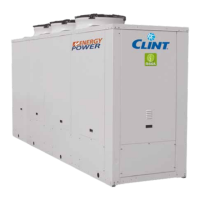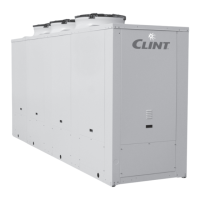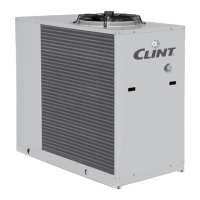23
CHA
6.3 VERIFICHE DURANTE IL FUNZIONAMENTO
6.3.1 Generalità
- Controllare che la macchina non generi rumori anomali
o vibrazioni eccessive.
- Controllare che la sequenza precedentemente de-
scritta si ripeta regolarmente, lasciando in funzione
ciascun compressore per almeno 10 minuti (se così non
fosse si dovrà aumentare l’inerzia dell’impianto).
- Verificare dopo qualche ora di funzionamento che
la corona dell’indicatore di liquido ed umidità segni
circuito secco.
- Verificare che non ci sia presenza di bollicine nel-
l’indicatore di liquido. La presenza delle suddette è
indice di scarsità di refrigerante (anche se può essere
ammessa qualche bolla).
- Dopo alcuni minuti dall’avviamento dei compressori,
durante il ciclo di funzionamento estivo, assicurarsi
chela temperaturadicondensazione siadi 18±4K
superiore alla temperatura dell’aria in ingresso al
condensatore e che la temperatura di evaporazione
siadicirca5Kinferioreallatemperaturadell’acquain
uscita dall’evaporatore (a seconda della grandezza
del refrigeratore, del gas refrigerante usato e della
temperatura ambiente).
- Verificare che la temperatura del surriscaldamento del
fluidofrigorigenosiacompresatra5e7K.Perfare
ciò, rilevare la temperatura da un termometro a con-
tatto posto sul tubo di aspirazione del compressore e
quella indicata sulla scala di un manometro connesso
anch’esso in aspirazione: la loro differenza fornisce il
valore del surriscaldamento.
- Verificare che la temperatura del sottoraffreddamento
delfluidofrigorigenosiacompresatra4e8K.Perfare
ciò, rilevare la temperatura da un termometro a contatto
posto sul tubo di uscita dal condensatore e quella indi-
cata sulla scala di un manometro connesso anch’esso
sulla presa del liquido all’uscita del condensatore: la loro
differenza fornisce il valore di sottoraffreddamento.
Le verifiche di cui sopra possono essere
effettuate utilizzando i manometri (se pre-
senti) forniti a corredo. In tal caso ricordarsi
di chiudere i rubinetti di intercettazione se
presenti una volta completati i rilievi.
6.3 CHECKS DURING UNIT OPERATION
6.3.1 General
- Check the unit for strange sounds or excessive vibra-
tions.
- Check that the above sequence is repeated regularly,
leaving each compressor working for at least 10
minutes (if this is not the case, unit inertia must be
increases).
- After a few operating hours, check that the crown of the
liquid and moisture indicator shows a dry circuit.
- Make sure there are no bubbles inside the liquid
indicator. Bubbles indicate there is not enough refrig-
erant liquid in the circuit (though a few bubbles are
accepted).
- A few minutes after the compressors start during the
summer operating cycle, make sure the condensation
temperatureis18±4Khigherthanthetemperature
of the air entering the condenser (depending on the
size of the chiller, the kind of refrigerant gas used
and the room temperature) and that the evaporating
temperatureisabout5Klessthanthetemperatureof
the water leaving the evaporator.
- Make sure that the overheating temperature of the
refrigerantliesbetween5and7K.Dothisbymeasuring
the temperature with a contact thermometer placed on
the suction pipe of the compressor and that indicated
on a pressure gauge connected to the suction line as
well: the difference between the two gives the values
of overheating.
- Make sure that the subcooling temperature of the
refrigerantfluid lies between 4and 8K. Dothis by
measuring the temperature with a contact thermometer
placed on the suction pipe of the compressor and
that indicated on a pressure gauge connected to the
suction line as well: the difference between the two
gives the values of subcooling.
The above checks can be made by using the
supplied pressure gauges (if fitted). In this
case, remember to close the shut-off valves
(if fitted) after making the measurements.

